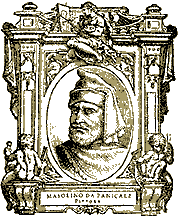painter
Panicale, San Giovanni Valdarno 1383?-1440 ca
Tied to the late Gothic style and influenced by the ideas of Ghiberti, Masolino probably appeared on the artistic scene in the early years of the fifteenth century, though nothing remains of his work until the year 1423 (the Madonna of Brema and the Madonna of Munich). He was already a fairly well known painter in Florence, though not exactly famous, at the time of his fatal encounter with that great artist Masaccio, who had come to the city from his native Valdarno to work in the workshop of his fellow townsman, who was then about twenty years his senior. Although people believed for a long time that Masaccio was Masolino's pupil, this, as a matter of fact, was not the case at all. Instead Masolino immediately realised that Masaccio's painting contained the most extraordinary qualities and novelty and, as a result, shared two important commissions with the young artist: the St. Anne, today in the Uffizi (1424 ca.), and the frescoes in the Brancacci Chapel (1424-28).

Fresco, in the Brancacci Chapel
Masaccio died shortly afterwards, when he was only 27 years old, but
Masolino never forgot what he had been taught and, for the rest of his
life, tried to instil his basically Gothic manner of painting with the
plastic, perspective and classical contents of the new style that he
had learnt in the Brancacci Chapel. Masolino's painting was never revolutionary
but became a rather lively modernization of the Gothic style, it was
still basically dependent on the outline but he also began to use softer,
more natural effects and delicate shading. His architecture rigorously
followed the new perspective rules but continued to be simply a decorative
frame that served as a surrounding for paintings of mediaeval legends
containing enchanted heroes.
His life and work was also marked by the periods he spent at the Hungarian court
(1425), in Rome (the frescoes in San Clemente, the Chapel of St. Catherine, 1428)
and, above all, at Castiglione Olona (Varese), where from 1435 he worked in the
Collegiate (the Stories of the Virgin) and in the Baptistery (the Stories of
the Baptist); here he can be seen to have absorbed the new conceptions of the
use of light that were a prelude to the work of Domenico Veneziano.

